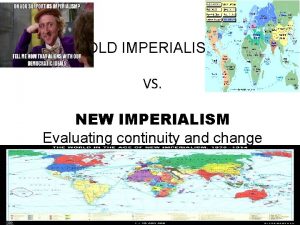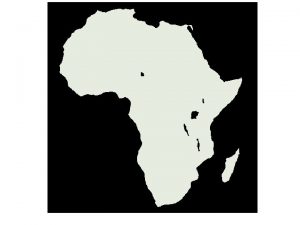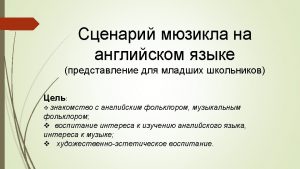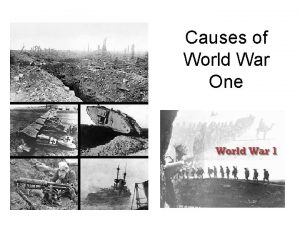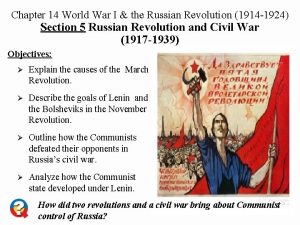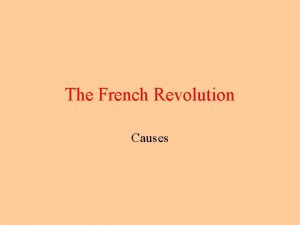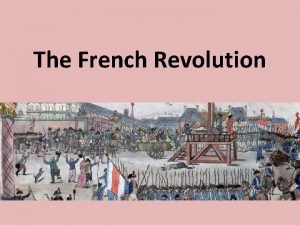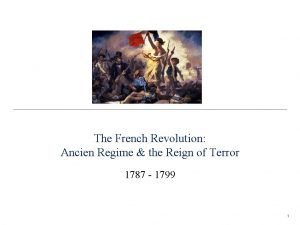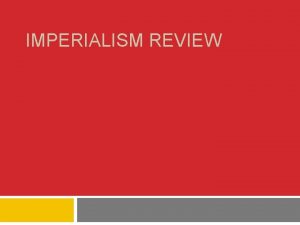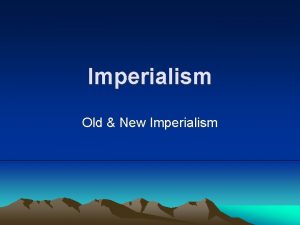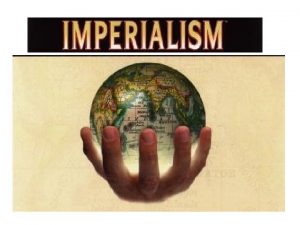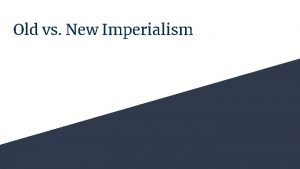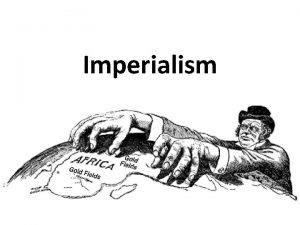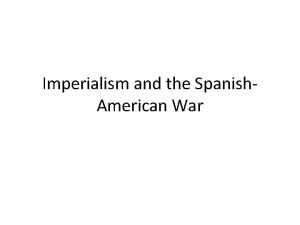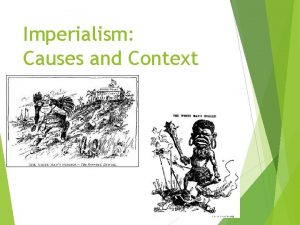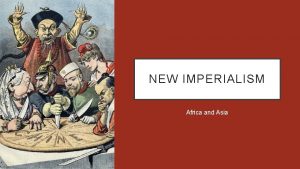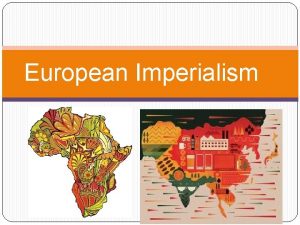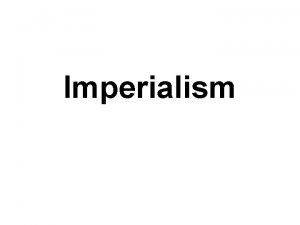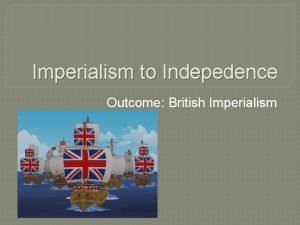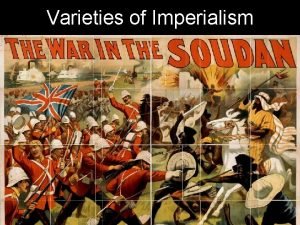WAR AND REVOLUTION IMPERIALISM Old Imperialism and the


























- Slides: 26

WAR AND REVOLUTION

IMPERIALISM • • Old Imperialism and the New Imperialism Old imperialism • European powers had practiced a form of imperialism between the 16 c and 17 c. During this period, Portugal, the Dutch Republic and England built trading post empires along the coasts of Africa, India and Indonesia • The New World was a notable exception to this pattern. Spain established an enormous empire in Central and South America while England colonized the east coast of North America.

• New Imperialism • Beginning in 1870, European nations exercised increasing economic and political control over Africa and Asia. No longer content to trade with other peoples, European nations now aimed to directly rule vast regions of the world. • The imperialist powers seized control over some areas such as German East Africa and French indo-China. In other areas, they established protectorates where the dependent country had its own government but was still subject to the authority of imperial power. And finally, the great powers established spheres of influence over large parts of China.

• Motives for the New Imperialism • Industrialists searched for new sources of raw materials and new markets for their finished goods. • Militarists and nationalists sought power and prestige • Social Darwinists believed that strong nations had a natural right to dominate weaker peoples. • Missionaries believed that Europeans had a duty to undertake a “civilized mission” to bring Christianity and the blessings of advanced technology to less fortunate people.

• • The “Scramble for Africa” • The most aggressive example of the new imperialism took place in Africa. • The so-called “Scramble for Africa” became so frenetic and rapacious that Otto von Bismarck called for an international conference in Berlin. The 14 nations that attended the 1885 Berlin Conference established rules for dividing Africa • Led by Great Britain, France and Germany, the European powers successfully partitioned almost the entire continent of Africa. Only Liberia and Abyssinia (Ethiopia) remained independent. Consequences of the New Imperialism • Damaged and sometimes destroyed native cultures • Created a global economy • Intensified European rivalries • European. Colonialism. In. Africa. ppt

THE MARCH TO WAR • Germany and the New Balance of Power • Germany’s industrial capacity, population, and military power all dramatically increased. In 1900, Germany produced more steel than Great Britain and France. Germany’s population increased from 41 million in 1871 to 64 million in 1910. In contrast, France had just 40 million in 1910 • European leaders from Cardinal Richelieu to Prince Klemens von Metternich had feared a united Germany. Their fears now became a reality. As Germany’s power surged, its leaders demanded respect and a new “place in the sun. ” • Bismarck’s network of Alliances • The French were humiliated by their defeat in the Franco-Prussian War and embittered by their loss of Alsace-Lorraine • In an attempt to isolate France, Bismarck formed a military alliance with Austria-Hungary in 1879. Three years later, Italy joined these two, thus forming the Triple Alliance. • In 1887, Bismarck took yet another ally away from France by signing a treaty with Russia.

• William II’s aggressive policies • In 1890, Kaiser William II forced Bismarck to resign. • William II promptly set Germany on a new course by letting the treaty of friendship with Russia lapse. • William II then challenged Britain’s long standing naval supremacy by embarking on an expensive program of naval expansion that poisoned relations between the two countries.

• The formation of the Triple Entente • France immediately offered Russia financial investments and diplomatic friendship. The two nations signed a Franco-Russian Alliance in 1894. • Alarmed by Germany’s growing naval power, Britain abandoned its policy of “splendid isolation” In 1904, Britain concluded a series of agreements with France collectively called the Entente Cordiale. With French support, the British concluded a similar agreement with Russia, thus forming the Triple Entente. • Germany’ tested the Anglo-French entente by challenging France’s plan to dominate Morocco. However, Germany’s belligerent actions only served to draw France and Britain closer together. • Two rival alliances now confronted each other. A dispute between any two powers could easily escalate into a major war.

• The Balkan Powder Keg • As the power of the Ottoman Empire receded, the Balkan Peninsula became a powder keg of competing interests. • With the exception of the Greeks and the Romanians, most of the Balkan population spoke the same Slavic language. Many Slavs embraced Pan-Slavism, a national movement to unite all Slavic peoples. • Bismarck recognized the potential danger of nationalist aspirations in the Balkan. At the 1878 Congress of Berlin, he tried to reduce tensions by supporting Serbian independence and Austrian-Hungary’s right to “occupy and administer” Bosnia and Herzegovina. • The newly independent nation of Serbia quickly became the leader of the Pan-Slavic movement. Serbian leaders hoped to unite the Slavs in the way Piedmont had united the Italians and Prussia the Germans.

• The Balkan Powder Keg Cont. • Austria felt threatened by the growth of Slavic nationalism within its borders and across the Balkans. In 1908, the Austrians enraged the Serbs by annexing Bosnia and Herzegovina. • Serbian nationalism threatened Austria. At the same time, it offered Slavic Russia an opportunity to advance its interests in the Balkans. • Russia and Austria-Hungary were thus on a collision course in the Balkans. As one Balkan crisis followed another, Europe tottered on the brink of war. • The Outbreak of War • On June 28, 1914, a 19 year –old Serbian nationalist, Gavrilo Princip, assassinated Archduke Francis Ferdinand, the heir to the Austrian throne. • The assassination set in motion a sequence of events that plunged Europe into war. In August 1914, millions of soldiers marched off to battle, convinced the war would be over in a few weeks. Crash Course #36 WWI

• TEST TIP: • AP European textbooks devote lengthy discussions to the complex sequence of events that led to the outbreak of WWI. Interestingly, APEURO test writers devote very few MC questions to this topic. Don’t become bogged down trying to memorize the details of the Balkan wars and the exchange of ultimatums between the Great powers. Devote the majority of your time to studying the consequences of WWI for the home front, for Russia and for postwar Europe.

THE WAR IN THE WEST • The Schlieffen Plan • Germany faced the task of simultaneously fighting France on its western border and Russia along a lengthy eastern front. • In order to prevent a two–front war, General Alfred von Schlieffen drew up a master plan calling for an all–out attack against France. The Schlieffen Plan gambled that France could be knocked out of the war before Russia had a chance to fully mobilize its forces. • A lighting attack on France meant invading neutral Belgium. • Germany’s unprovoked attack on Belgium outraged Britain. On Aug. 4, 1914, Britain declared war on Germany.

• Stalemate • The Schlieffen Plan narrowly failed, making a quick victory impossible. • Both sides now constructed an elaborate system of trenches stretching more than 600 miles from the English Channel to the Swiss border. • Trench warfare produced a stalemate that lasted about four years and claiming unprecedented casualties. • The Home Front • Total war • When it became clear that the war would not be over quickly, governments mobilized all human and industrial resources in order to wage total war. • Governments tightly controlled the news and used propaganda to rally public morale and arouse hatred of the enemy.

• Home Front Cont. • The role of women • As more and more men went to war, millions of woman replaced them in factories, offices, and shops. WWI marked the first time that the employment of women was essential to sustain war effort. • In the decade prior to WWI, British women led by Emmeline Pankhurst waged an aggressive campaign for women’s suffrage. During the war, pankhurst called a halt to militant suffrage activities, urging women to contribute to the war effort. • In 1918, Parliament granted the suffrage to women over the age of 30. • All Quiet on the Western Front • All Quiet on the western front is a war novel written by Erich Maria Remarque, a German veteran of WWI. • Remarque vividly described the senseless slaughter and suffering endured by soldiers on the western front.

THE RUSSIAN REVOLUTION • The End of Romanov Rule • The poorly equipped Russian army was no match for the German war machine. By 1917, more than 7 million Russian soldiers had been killed, wounded or taken prisoner. • Nicholas II proved to be an inept ruler. As battlefield losses mounted and shortages of food worsened, Nicholas moved his headquarters to the front in a futile attempt to rally his troops. • In early 1917, food shortages in Petrograd (formerly St. Petersburg) led to spontaneous demonstrations and strikes. • Nicholas ordered his troops to restore order, but the soldiers refused and instead supported the demonstrators. On March 12, 1917, Nicholas abdicated, ending three centuries of Romanov rule.

• The Provisional Government • A provisional government led by Alexander Kerensky replaced the tsar. • Despite mounting losses, the provisional government continued the war against Germany. This fateful decision to pursue an unpopular weakened the provisional government and played a key role in its demise. • Vladimir Lenin and the Bolshevik Revolution. • While the Russian army was falling apart, the Germans helped Lenin return to Petrograd. Lenin arrived at the Finland Station on Apr. 3, 1917, and promptly urged his followers to overthrow the provisional government.

• Lenin’s Key Ideas • Lenin denounced gradual reform, arguing that capitalism could only be destroyed by class conflict. • Lenin insisted that a communist revolution was possible in a nonindustrial zed country such as Russia. • Lenin argued that Russia’s relatively small working class could not develop a revolutionary class consciousness. Instead, leadership would have to come from a highly disciplined group of professional revolutionaries. • Lenin’s slogan of “Peace, land bread” captured the popular imagination and enabled the Bolsheviks to win widespread popular support. • Lenin sensed that it was time to act. “History will not forgive us” Lenin wrote, “ if we do not seize power now. ” on the night of Nov. 6, 1917, the Bolsheviks occupied most government buildings. The next day Lenin proclaimed establishment of a new Bolshevik government.

• The Treaty of Brest-Litovsk • Lenin realized that the survival of the Bolshevik regime depended upon the ending of the war with Germany. • In March 1918, the Bolsheviks reluctantly agreed to the Treaty of Brest -Litovsk. Under the terms of this treaty, Russia lost a quarter of its European territory and a third of its population. • It is important to note that Russia later repudiated the treaty, and it was declared nul and void by the Allies. • Civil War • By the summer of 1918, several “White” armies attempted to overthrow the Bolsheviks. • Led by Leon Trotsky, the Bolsheviks responded by forming a highly disciplined Red Army. • The civil war between the Whites and the Reds lasted from 1918 to 1920. the divided and poorly led Whites lost to the better-organized Red Army.

• TEST TIP: • Lenin’s pivotal role in the Russian Revolution has generated a significant number of MC questions on the APEuro test. Be sure you study Lenin’s key ideas. It is interesting to compare Lenin’s decisive leadership with the weakness and vacillation of Tsar Nicholas II and Alexander Kerensky.

THE PEACE SETTLEMENT • The end of WWI • The Treaty of Brest-Litovsk enabled the Germans to transfer divisions from the east to help launch a great spring offensive. • Reinforced by newly arrived American troops, the British and the French halted the German offensive. • Realizing that defeat was imminent, William II abdicated his throne and Germany became a republic. Two days later on Nov. 11, 1918, WWI came to an end. • The Guns of August - You. Tube

• The Fourteen Points • President Woodrow Wilson became the spokesman for a just and lasting peace. • Wilson’s Fourteen Points included a call for the following: • Open diplomacy • Freedom of the seas • Reduction of national armaments • Return of Alsace-Lorraine to France • A free and independent Poland with access to the sea • National self-determination for oppressed minority groups • Creation of a “general association of nations” to preserve the peace and security of its members. • Wilson’s idealistic proposals were undermined by secret treaties and by a desire to punish Germany.

• The Paris Peace Conference • Although nearly 30 countries were represented, Great Britain, France and the United States made the major decisions. (why the US? ) • Germany and Austria-Hungary were not allowed to attend the conference. • Russia, which had suffered the greatest loss of life, was in the midst of a civil war and was not invited to attend the conference.

• The Treaty of Versailles • Germany lost 13% of its land, including Alsace-Lorraine. • Germany’s territories in Africa and the Pacific were given as mandates to Britain, France and Japan. A mandate was a territory that was administered on behalf of the League of Nations. • Poland once again became an independent nation. The new Poland received a large strip of German land called the Polish Corridor. This strip cut off East Prussia from the rest of Germany and gave Poland access to the sea. • Germany’s army was limited to 100, 000 men and forbidden to have artillery, aircraft, or submarines. • The east bank of the Rhine river was to be demilitarized, and the allies were to have the right to occupy the Rhineland for 15 years

• The Treaty of Versailles cont. • Germany was declared guilty of starting the war and forced to pay huge payments called reparations. (over $30 billion) • The allies created a League of Nations to discuss and settle disputes without resorting to war. • The final signing ceremony took place in the Hall of Mirrors at Versailles, the same room in which Bismarck’s German empire had been proclaimed in 1871. • A new map of Europe • Austria-Hungary was dissolved and the Habsburg monarchy eliminated. Austria and Hungary became separate states. In addition, territories from Austria-Hungary were given to the newly created states of Czechoslovakia and Yugoslavia. • The Serbs dominated Yugoslavia • Finland the three Baltic states –Estonia, Latvia and Lithuaniaemerged from the tsarist empire.

• History of Europe between the Two World Wars 1918 -1942 : Europe after World War I • Take some time to compare/contrast the Congress of Vienna to the Paris Peace Conference

MAKING COMPARISONS: THE CONGRESS OF VIENNA AND THE PARIS PEACE CONFERENCE • The Congress of Vienna • Allowed defeated France to participate in peace conference negotiations • Established a framework for future international relations based on periodic meetings, of congresses, among the great powers • Restored a conservative order based upon the institutions of monarchy and aristocracy • Created a balance of power that lasted for over 50 years • The Paris Peace Conference • Refused to allow Germany or Russia to participate in peace negotiations. • Established a framework for future international relations based on the League of Nations. • Witnessed the birth of democratic order with the elimination of monarchies in Germany, Russia and Austria-Hungary. • Created a legacy of bitterness between both the victors and the defeated, which led to a second world war in just 20 years.
 Old vs new imperialism chart
Old vs new imperialism chart Old imperialism motives
Old imperialism motives Once upon a time there was a poor girl
Once upon a time there was a poor girl Once upon a time there lived an old man and an old woman
Once upon a time there lived an old man and an old woman Why was imperialism a cause of world war i
Why was imperialism a cause of world war i Russian revolution vs french revolution
Russian revolution vs french revolution Did american revolution cause french revolution
Did american revolution cause french revolution Green revolution vs third agricultural revolution
Green revolution vs third agricultural revolution World war 1 and the russian revolution chapter 27
World war 1 and the russian revolution chapter 27 Chapter 14 world war 1 and the russian revolution
Chapter 14 world war 1 and the russian revolution What are the main causes of french revolution
What are the main causes of french revolution What's your name is
What's your name is Once upon a time there lived a little girl
Once upon a time there lived a little girl The french revolution timeline
The french revolution timeline War with austria french revolution
War with austria french revolution Toward civil war lesson 3 secession and war
Toward civil war lesson 3 secession and war War at home vs war abroad madison
War at home vs war abroad madison Description
Description The cold war lesson 1
The cold war lesson 1 Sclc and sncc venn diagram
Sclc and sncc venn diagram Why did josette dugas want to go to war
Why did josette dugas want to go to war Ich sein
Ich sein Contact force examples
Contact force examples Why was the civil war the first modern war
Why was the civil war the first modern war Ich war du warst er war
Ich war du warst er war Proxy wars in cold war
Proxy wars in cold war Chapter 30 the war to end war
Chapter 30 the war to end war
